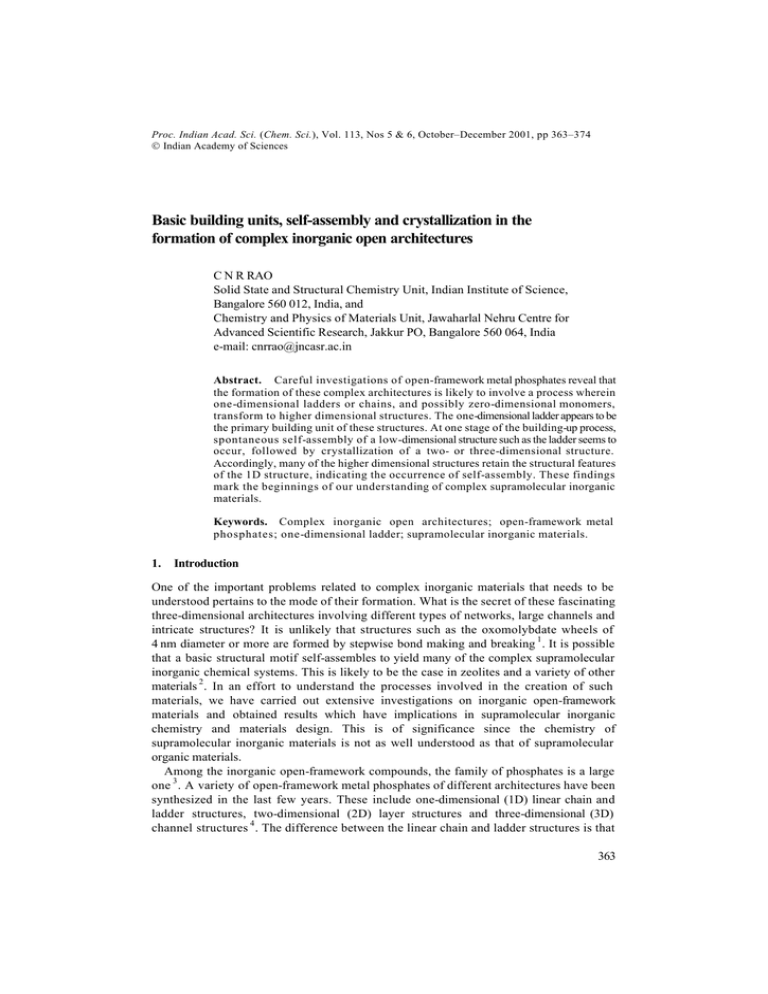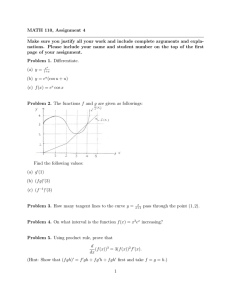Basic building units, self-assembly and crystallization in the
advertisement

Proc. Indian Acad. Sci. (Chem. Sci.), Vol. 113, Nos 5 & 6, October–December 2001, pp 363–374 Indian Academy of Sciences Basic building units, self-assembly and crystallization in the formation of complex inorganic open architectures C N R RAO Solid State and Structural Chemistry Unit, Indian Institute of Science, Bangalore 560 012, India, and Chemistry and Physics of Materials Unit, Jawaharlal Nehru Centre for Advanced Scientific Research, Jakkur PO, Bangalore 560 064, India e-mail: cnrrao@jncasr.ac.in Abstract. Careful investigations of open-framework metal phosphates reveal that the formation of these complex architectures is likely to involve a process wherein one-dimensional ladders or chains, and possibly zero-dimensional monomers, transform to higher dimensional structures. The one-dimensional ladder appears to be the primary building unit of these structures. At one stage of the building-up process, spontaneous self-assembly of a low-dimensional structure such as the ladder seems to occur, followed by crystallization of a two- or three-dimensional structure. Accordingly, many of the higher dimensional structures retain the structural features of the 1D structure, indicating the occurrence of self-assembly. These findings mark the beginnings of our understanding of complex supramolecular inorganic materials. Keywords. Complex inorganic open architectures; open-framework metal phosphates; one-dimensional ladder; supramolecular inorganic materials. 1. Introduction One of the important problems related to complex inorganic materials that needs to be understood pertains to the mode of their formation. What is the secret of these fascinating three-dimensional architectures involving different types of networks, large channels and intricate structures? It is unlikely that structures such as the oxomolybdate wheels of 4 nm diameter or more are formed by stepwise bond making and breaking 1 . It is possible that a basic structural motif self-assembles to yield many of the complex supramolecular inorganic chemical systems. This is likely to be the case in zeolites and a variety of other materials 2 . In an effort to understand the processes involved in the creation of such materials, we have carried out extensive investigations on inorganic open-framework materials and obtained results which have implications in supramolecular inorganic chemistry and materials design. This is of significance since the chemistry of supramolecular inorganic materials is not as well understood as that of supramolecular organic materials. Among the inorganic open-framework compounds, the family of phosphates is a large one 3 . A variety of open-framework metal phosphates of different architectures have been synthesized in the last few years. These include one-dimensional (1D) linear chain and ladder structures, two-dimensional (2D) layer structures and three-dimensional (3D) channel structures 4 . The difference between the linear chain and ladder structures is that 363 364 C N R Rao four-membered metal phosphate units of the type M2 P2 O4 share corners and edges respectively in these two 1D systems. Monomeric four-membered zinc phosphates have been synthesised and characterized recently 5 . Several open-framework metal carboxylates have also been reported 6 and the presence of a hierarchy of zinc oxalates covering the monomer, dimer, chain, honeycomb-layer and 3D structures has indeed been established 7 . Most of the open-framework phosphates, oxalates and other compounds are prepared under hydrothermal conditions in the presence of an organic amine, which is considered to be a structure-directing agent. There are many intriguing aspects of these materials. Thus, under identical synthetic conditions, one often obtains several 3D and other compounds, from the same pot. The use of different amines results in products with differing structures with no obvious relationship, and at the same time, one amine can also yield compounds of various structures and dimensionalities 8 . While it is recognized that the reactions occur under kinetic control rather than thermodynamic control, we are not able to understand many aspects of these reactions which give rise to such a rich variety of different structures. Why and how are these open architectures formed? What is the real role of the organic amine which is considered to be a structure-directing agent? Is there a relationship amongst the structures of different dimensionalities? Can one identify a primary building unit responsible for the ultimate formation of complex 3D structures? Is self-assembly, rather than a step-wise process, involved at some stage of the building process? We have attempted to answer these important questions in the case of open-framework phosphates 9 and I shall discuss some of the salient features of our findings in this article. 2. Structures of different dimensionalities In figure 1, we show typical 1D, 2D and 3D structures of open-framework metal phosphates. In the case of the 1D structures, we have shown a linear-chain structure containing corner-shared four-membered rings and a ladder structure with edge-shared four-membered rings. Looking at these 1D structures, it would appear that the fourmembered ring is the primary building unit of these materials. As mentioned earlier, zero-dimensional (0D) monomeric zinc phosphates containing the four-membered ring have been prepared and characterized 5,10. The availability of pure 0D, 1D and 2D compounds has enabled us to investigate the relationships amongst the metal phosphates of different dimensionalities and the transformations amongst them. 3. Amine phosphate route to open-framework structures Before we examine the transformations of the low-dimensional (0D, 1D and 2D) metal phosphates, a few recent observations related to the role of the amine in the synthesis would be in order 8,11,12. Organic amines are routinely used in the hydrothermal synthesis of these materials. While the pH of the medium, hydrogen bonding, and other factors may determine the role of the amine in the formation of open-framework metal phosphates, it seemed to us that the amines may be involved in a more direct manner as well. This is because we often find organic amine phosphates as side products in the hydrothermal synthesis of open-framework metal phosphates. These materials, being Figure 1. Open-framework metal phosphates of different dimensionalities: 1. 1D linear chain structure with piperazine, [C 4N2H10] [Zn(HPO 4)2].H2O; 2. 1D ladder structure, [C 6N4H22]0⋅5 [Zn(HPO 4)2] with triethylenetetramine (TETA); 3. 2D layer phosphate with TETA, [C 6N4H22]0⋅5 [Zn 2(HPO 4)3]; 4. 3D structure with 16 -membered channels with TETA, [C6N4H22]0⋅5 [Zn 3(PO 4)2(HPO 4)]. Formation of complex inorganic open architectures 365 Figure 2. Reaction of an organic amine phosphate with Zn(II) ions to give a ladder and a layer phosphate. 366 C N R Rao Formation of complex inorganic open architectures Figure 3. 367 Transformations of a zero-dimensional monomeric zinc phosphate. water soluble, are generally ignored since the preoccupation of most workers in the field has been to isolate open-framework structure compounds which come out as crystals on cooling the mother solutions. We considered it important to examine the possible role of 368 C N R Rao Figure 4. Transformations of a one-dimensional zinc phosphate with a ladder structure. amine phosphates 11,12. We soon found that amine phosphates react with metal ions such as Zn(II) and Co(II) under simple conditions to yield open-framework structures of different dimensionalities. Furthermore, the reactions could be carried out even at relatively low temperatures under ambient pressure. Thus, the reaction of 1,3diaminopropane phosphate with Zn(II) ions at room temperature gave ladder (1D) and Formation of complex inorganic open architectures Figure 5. structure. 369 Transformations of a two-dimensional zinc phosphate with a layer layer (2D) phosphates (figure 2). This is important not only because we can eliminate hydrothermal reaction conditions and carry out simple test tube reactions under mild conditions, but also because the amine phosphate route can be exploited to synthesize new and novel open-framework metal phosphates, including 0D and 1D materials 12 . The in-situ synchrotron X-ray diffraction experiments carried out recently on the reaction of 370 C N R Rao piperazine phosphate with Zn(II) ions have shown that a one-dimensional phosphate is formed first, followed by 3-dimensional structures 13 . This observation is indicative of a sequential building up process from low- to high-dimensional structures. 4. Transformations of zero- and one-dimensional structures We now examine the transformations of low dimensional structures to higher dimensional ones 9,10,14. Zero-dimensional monomers of the type [C6 N2 H18 ] [Zn(HPO4 )(H2 PO4 )2 ] transform under simple reaction conditions to 1D, 2D and 3D structures. The monomers comprising a 4-membered ring are not easy to isolate possibly because they readily transform to the more complex structures. In figure 3, we show the transformations of a 0D monomer to higher dimensional structures. Such transformations may involve the elimination of H3 PO4 , rotation of bonds and condensation. One-dimensional ladder compounds of the type [C6 N4 H22 ]0⋅5 [Zn(HPO4 )2 ] transform to 2D layered compounds and 3D channel structures. In figure 4, we show the transformations of a ladder phosphate. The transformations generally occur through the process of deprotonation of the phosphoryl group, and the elimination of the HPO4 unit. Detailed transformation studies indicate that the one-dimensional ladder is most crucial for the building-up of the complex open-framework phosphate structures. This is supported by a study of the transformations of two-dimensional layer structures. 5. Transformation of two-dimensional structures Having found that the 0D and 1D structures transform to higher-dimensional 2D and 3D structures under simple reaction conditions, it was of interest to determine whether the 2D layer structures transform to 3D structures. Systematic investigations of the transformations of layered zinc phosphates 15 show that on heating in water, the layered compounds transform to a 1D ladder structure along with a 3D structure or just a 1D ladder structure alone (figure 5). On heating with amines such as piperazine, the 2D structures transform to a 1D linear chain structure which gives rise to other 3D structures. The parent amine present in the 2D structure often gets replaced by the added amine. It appears that the primary product of the transformation of the 2D structures is the ladder structure which subsequently forms 2D or 3D structures. This observation reinforces the view that the ladder structure is probably the primary building unit of open-framework metal phosphates. 6. Self-assembly and crystallization A comment on the nature of the transformation of one-dimensional structures to more complex structures would be in order. Based on in-situ synchrotron X-ray diffraction studies 16 , there is reason to believe that at some stage of the formation of complex 3D metal phosphates, there is spontaneous assembly. Our studies suggest that the ladder structure may indeed self-assemble to yield the 2D and 3D structures. Self-assembly here is not as simple as in organic compounds but involves orientation of the building units followed by simple reactions such as deprotonation and condensation. Evidence for such self-assembly is found in the observation that 2D and 3D structures retain the elements of the ladder structure, as illustrated in figure 6. In figure 7, we show how a ladder structure when connected by edge-sharing with a 4-membered ring can give rise to a 3D-structure Formation of complex inorganic open architectures 371 Figure 6. Structures of 2D and 3D phosphates showing the elements of the ladder structure from which they were formed. with 8-membered channels as in gismondine. Some of the 2D and 3D structures formed by the transformation of the 1D linear chain structures retain features of the chain. The linear chain may itself be formed from a ladder structure, rather than the other way as suspected earlier in the case of aluminum phosphates 17 . The linear chains do, however, transform under simple reaction conditions to 3D structures 15,18. 372 C N R Rao Figure 7. Relationship between the ladder structure and the 3D gismodine structure obtained on transformation. Figure 8. Chart showing various types of low–high D transformations in openframework zinc phosphates. Primacy of the 1D ladder structure can be seen. Formation of complex inorganic open architectures 373 A noteworthy feature in the transformations of 1D and 2D structures is that we readily obtain single crystals of the 3D structures as products, although we start with powders of the 1D/2D compounds, generally in solution. The ready crystallization of the 3D structures and the formation of single crystals is likely to be related to the process of selfassembly in these systems. We can represent the different steps as follows: ladder nucleation (crystallization) 7. spontaneous self-assembly 3D structure (single crystalline) Concluding remarks Various results from the studies of open-frame metal phosphates not only show the relationships between the structures of different dimensionalities, but also reveal a building-up principle from low-dimensional structures to higher dimensional ones. The transformations of 0D and 1D ladder structures to 2D and 3D structures is particularly significant and represents the first clear demonstration of such progressive building-up of complex 2D and 3D structures starting from low-dimensional structures. In figure 8, we show the various transformations found hitherto. The occurrence of self-assembly during the building-up process is of great significance. Thus, the study of open-framework phosphates has thrown light on a problem of great current interest by showing the relation between basic building units of low dimensionality and open architectures of higher dimensionality, and the role of self-assembly and crystallization in the formation of these structures. Acknowledgement The author acknowledges close collaboration with Prof. A K Cheetham and Drs A Choudhury, S Natarajan and S Neeraj in this area of research. References 1. 2. 3. 4. 5. 6. 7. 8. 9. 10. 11. 12. Miller A, Reuter H and Dillinger S 1995 Angew. Chem., Int. Ed. Engl. 34 2328 Ferey G 2000 J. Solid State Chem. 152 37 Cheetham A K, Ferey G and Loiseau T 1999 Angew. Chem., Int. Ed. Engl. 38 3268 Rao C N R, Natarajan S, Choudhury A, Neeraj S and Vaidhyanathan R 2001 Acta Crystallogr. B57 1 Neeraj S, Natarajan S and Rao C N R 2000 J. Solid State Chem. 150 417 Livage C, Egger C and Ferey G 1999 Chem. Mater. 11 1546, and references therein Vaidhyanathan R, Natarajan S and Rao C N R 2001 J. Chem. Soc., Dalton Trans. 699, and references therein Choudhury A, Natarajan S and Rao C N R 2000 Inorg. Chem. 39 4295 Rao C N R, Natarajan S, Choudhury A, Neeraj S and Ayi A A 2001 Acc. Chem. Res. 2001 34 80 Ayi A A, Choudhury A, Natarajan S, Neeraj S and Rao C N R 2001 J. Mater. Chem. 11 1181 Neeraj S, Natarajan S and Rao C N R 1999 Angew. Chem., Int. Ed. Engl. 38 3480 Rao, C N R, Natarajan S and Neeraj S 2000, J. Am. Chem. Soc. 122 2810 374 C N R Rao 13. Walton R I, Norquist A J, Neeraj S, Natarajan S, Rao C N R and O’Hare D 2001 Chem. Commun. 1990 14. Choudhury A, Neeraj S, Natarajan S and Rao C N R 2001 J. Mater. Chem. 11 1537 15. Choudhury A, Neeraj S, Natarajan S and Rao C N R 2001 J. Mater. Chem. (communicated) 16. Francis R J, O’Brien S, Fogg A M, Halasyamani P S, O’Hare D, Loiseau T and Ferey G 1999 J. Am. Chem. Soc. 121 1002 17. Oliver S, Kuperman A and Ozin G A 1998 Angew. Chem., Int. Ed. Engl. 37 46 18. Walton R I, Millange F, Le Bail A, Loiseau T, Serre C, O’Hare D and Ferey G 2000 Chem. Commun. 203



